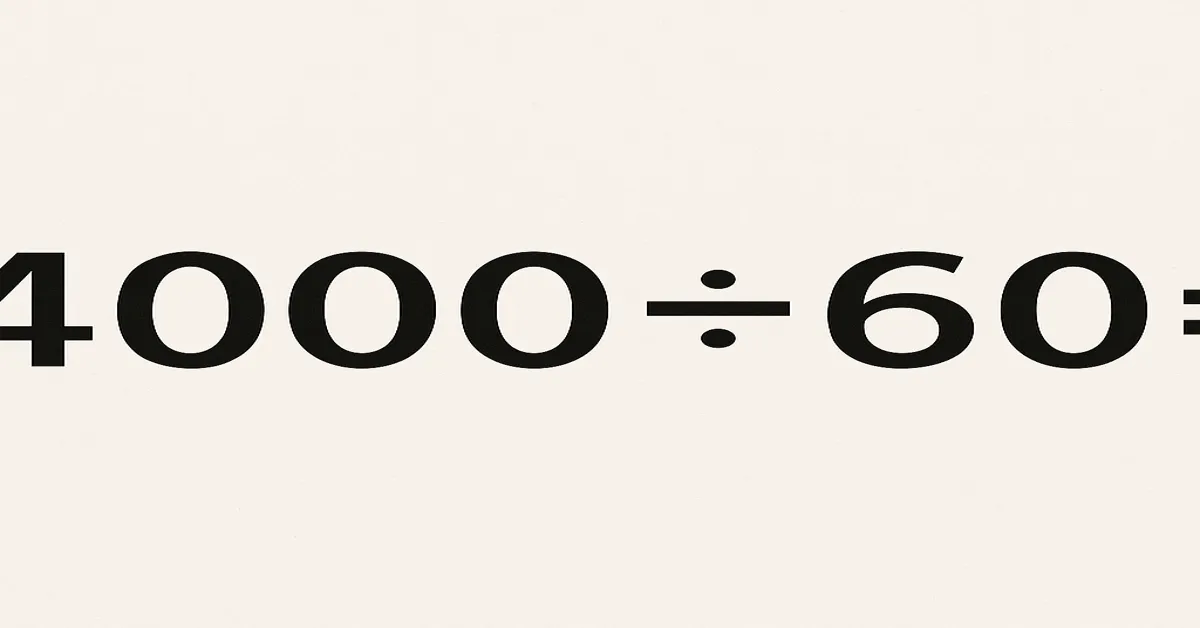At first glance, 4000 divided by 60 appears to be a simple mathematical operation. But in today’s data-driven, time-conscious world, 4000/60 is more than just arithmetic — it’s a lens into efficiency, performance, and the way we quantify modern life. This deceptively small calculation holds relevance across digital systems, industrial benchmarks, financial planning, and even human productivity. By unpacking what 4000/60 truly implies, we uncover deeper insights about how we manage resources, measure output, and understand time.
This is not just about solving for a number — it’s about understanding what the number represents, and how it shapes decision-making in unexpected places.
Breaking Down the Math
To begin, let’s settle the math:
4000 ÷ 60 = 66.666…
Or, expressed as a more digestible figure: approximately 66.67.
But even here, the repeating decimal tells a story — one of approximation, compromise, and context. In an exacting world, do we round up or down? Do we accept the fraction or seek a cleaner number? These decisions can matter more than the result itself, depending on where the equation is applied.
Let’s explore where this figure appears and what it can tell us.
Chapter One: 4000/60 in Time Management – Hours and Minutes
In professional productivity and scheduling, 4000/60 converts units of time — specifically, minutes to hours. This division implies 4000 minutes being distributed or understood in the context of hours. The result? Roughly 66.67 hours, or 2.78 days of continuous time.
But what can be done in 66.67 hours? For knowledge workers, it might represent a workweek and a half. For a factory, it could be the runtime of a machine before maintenance. For a freelancer billing by the hour, it’s an invoice waiting to be processed.
This single conversion can inform:
- Project timelines
- Resource allocation
- Human capital analysis
- Production efficiency audits
Modern industries rely heavily on such granular conversions — taking raw numbers like “4000 minutes” and translating them into economic and operational meaning.
Chapter Two: 4000/60 in Computing – CPU and Data Transfer
In computing, 4000 divided by 60 often shows up in performance calculations. For example:
- Operations per minute: A processor that handles 4000 tasks in 60 seconds is running at 66.67 tasks per second, or 66.67 Hertz, depending on context.
- Frame rendering: A graphics card might process 4000 frames over 60 seconds, yielding an average frame rate — vital in gaming, animation, and simulation.
Why does this matter?
Because every second counts in digital environments. Whether it’s real-time rendering or data streaming, the concept of dividing larger tasks (4000 operations) over time (60 seconds) gives engineers, analysts, and developers a performance baseline.
This figure also appears in discussions around:
- Server requests per minute
- API throttling
- Cloud computing efficiency
And the implications are not merely technical. A higher 4000/60 rate could mean better user experience, faster processing, and lower latency — all metrics that directly affect revenue and customer satisfaction.
Chapter Three: 4000/60 in Transportation – Speed and Logistics
Let’s take a different lens. What happens when 4000 represents distance — say, meters or kilometers — and 60 is minutes or seconds? You get speed.
- 4000 meters / 60 seconds = 66.67 m/s
- 4000 kilometers / 60 hours = 66.67 km/h
In logistics and travel, this unit conversion can mean the difference between on-time and delayed deliveries. It also informs:
- Fuel efficiency benchmarks
- Autonomous vehicle training data
- Drone navigation patterns
When AI-powered transport systems calculate routes and speeds, they often break large values into time-segmented units. 4000 divided by 60 becomes not just a number, but a standard reference point to measure against — guiding behavior and optimizing performance.
Chapter Four: 4000/60 in Finance – Transactional Analysis
In fintech and economic modeling, 4000/60 may represent transactions, events, or units over a time period — a concept central to throughput analysis.
Consider a payment processor that handles 4000 transactions per hour. That’s 66.67 per minute — a throughput that can be measured against benchmarks, fraud detection limits, or processing costs.
This calculation touches areas like:
- Stock trades per minute
- Payment success rates
- Customer onboarding speed
- Call center performance (calls/hour)
Financial systems depend on precision. A drop from 66.67 to 60 transactions per minute might not seem like much — until you scale it globally, and see the revenue impact in the millions.
Chapter Five: 4000/60 in Education – Learning Time and Curriculum Planning
In academia, instructional time is a currency. Consider a school planning 4000 minutes of instruction across a 60-day term. That’s 66.67 minutes of instruction per day.
This calculation helps educators:
- Balance lesson plans
- Allocate subjects across weeks
- Adjust for holidays or special events
It also appears in e-learning models, where course time is tied to engagement rates and completion metrics. Online platforms often design lessons in chunks of 60 minutes. How many 4000-minute courses can be split efficiently across daily routines? The answer affects content delivery, learner fatigue, and knowledge retention.
Chapter Six: 4000/60 in Health and Fitness – Heartbeats and Exercise
In fitness tracking and medical monitoring, numbers like 4000/60 emerge in metrics such as steps, calories, or heartbeats per minute.
Example:
- 4000 steps in 60 minutes = 66.67 steps/minute — a moderate walking pace
- 4000 calories burned over 60 days = ~66.67/day — used in dietary tracking
Heart rate monitors might register data like 4000 beats over a monitored session, interpreted over the duration for average rates.
These conversions influence:
- Training intensity
- Caloric planning
- Recovery optimization
Athletes, trainers, and even smartwatch users base daily goals on such per-minute, per-hour, or per-day interpretations of raw cumulative numbers like 4000.
Chapter Seven: Philosophical and Humanistic Angles – The Number Beyond Numbers
Beyond science and operations, numbers shape how we perceive value, time, and control. 4000/60 becomes a metaphor — a reminder of how we segment experience into manageable units.
It asks questions like:
- How do we divide attention across tasks?
- How much can be achieved in 66.67 minutes?
- Is efficiency a product of raw output, or thoughtful segmentation?
In this light, 4000/60 becomes a poetic representation of the modern condition — always calculating, always optimizing, always dividing time into “what can be done now.”
The Power of One Simple Equation
We began with a question that might appear on a sixth-grade math quiz: What is 4000 divided by 60? But we’ve journeyed far from there.
Through each domain — from computing to logistics, finance to health — we find the same division used to model, interpret, and drive action.
4000/60 is not just a number. It’s a model. It’s a method. It’s a measure of momentum.
Real-World Use Cases: Quick Snapshots
| Context | Meaning of 4000/60 | Result |
|---|---|---|
| Digital Media | Frames processed per minute | 66.67 FPS |
| Workforce Management | Minutes logged over work hours | 66.67 hours |
| Transportation | Meters covered per second | 66.67 m/s |
| Fintech | Transactions processed per minute | 66.67 TPM |
| Education | Minutes of learning per school day | 66.67 minutes/day |
| Health/Fitness | Steps taken per minute | 66.67 SPM |
These are not just technical values; they drive dashboards, KPIs, health apps, and production schedules across the globe.
Final Thoughts: Why This Matters
In a hyperconnected era, the ability to understand, segment, and apply numbers with precision is more than academic — it’s existential. Whether managing global networks or daily habits, the simplicity of 4000/60 hides a profound complexity: the act of transforming quantity into quality.
It invites us to see more in less — to recognize that behind each calculation is a series of choices, optimizations, and human values. The answer may be 66.67, but the meaning is infinitely richer.
Read: WatchSeries PE: Inside the World of Free Streaming, Viewer Demand, and the Ethics of Online Access
FAQs
1. What is the result of 4000 divided by 60?
The result of 4000 ÷ 60 is approximately 66.67. This value is a repeating decimal (66.666…), which is often rounded to two decimal places depending on the context in which it’s used.
2. Why is 4000/60 important beyond just math?
While 4000/60 is a simple division problem, it holds practical meaning in various fields like time management, computing, logistics, finance, and education. It often represents a rate, speed, average, or performance measure — such as steps per minute, transactions per hour, or processing speed.
3. How is 4000/60 used in real-life situations?
Real-world examples include:
- Computing: 4000 operations in 60 seconds equals ~66.67 operations per second.
- Fitness: 4000 steps in an hour translates to ~66.67 steps per minute.
- Education: 4000 instructional minutes across 60 days = ~66.67 minutes per school day.
4. What unit of measurement does 4000/60 represent?
That depends on context. It could represent minutes per hour, items per minute, or kilometers per hour, among others. The division format 4000/60 often translates one unit (like total actions or time) into another more usable rate or pace.
5. How can understanding 4000/60 help in productivity?
Knowing how to interpret 4000/60 allows individuals and businesses to better plan, allocate, and optimize time and resources. It can help assess work output, measure task efficiency, or distribute workload evenly over a given period.











